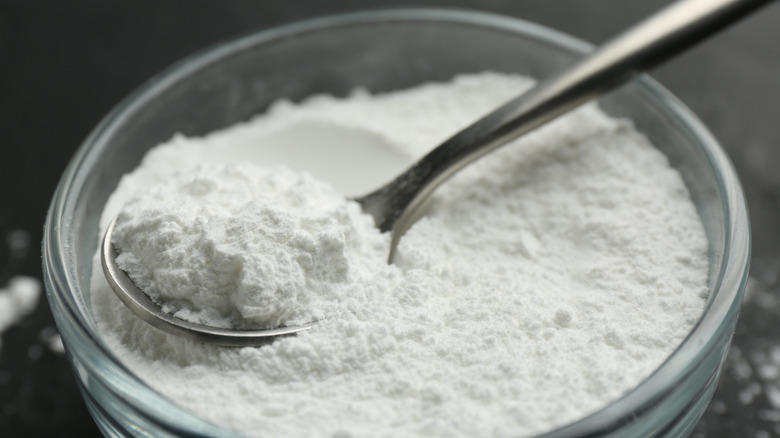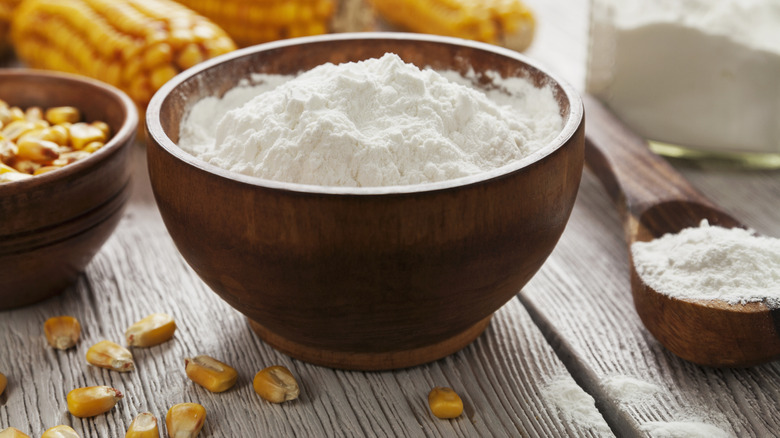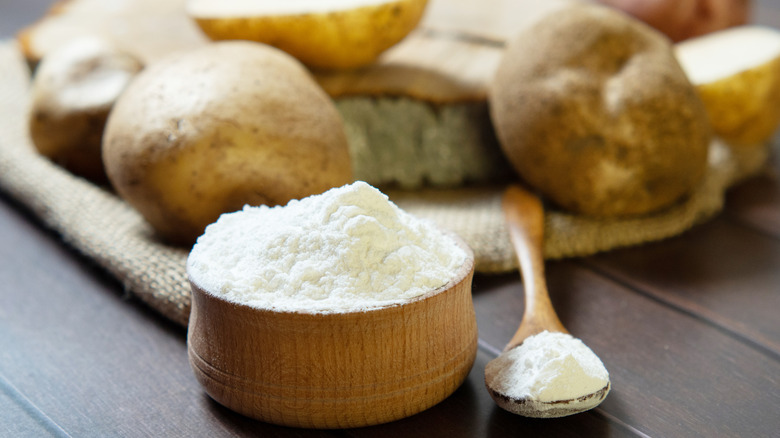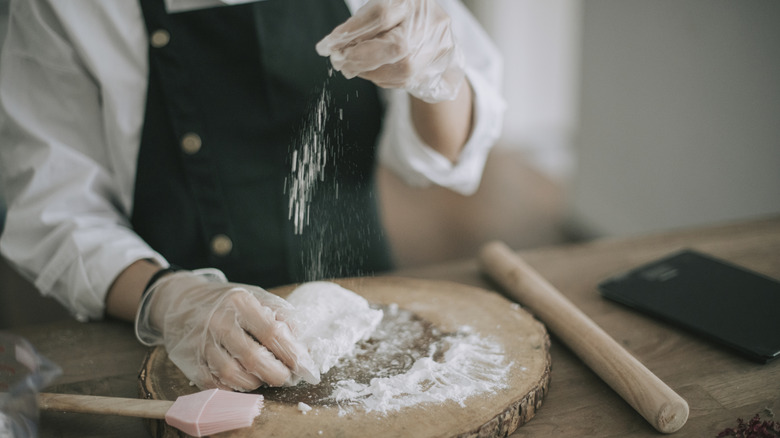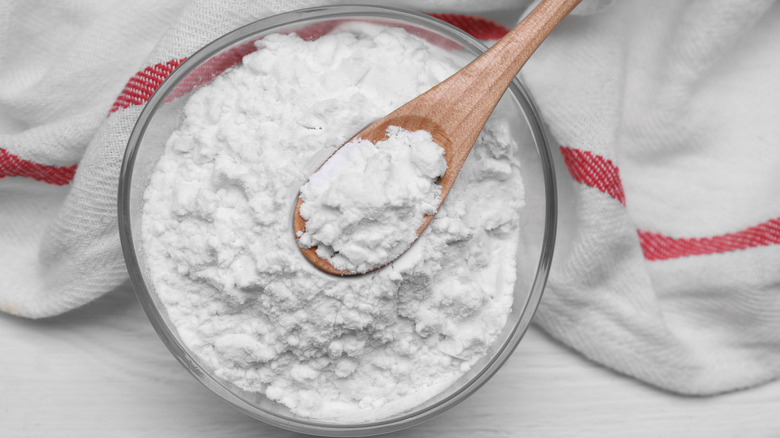Cornstarch Vs Potato Starch: Which Is Better?
Starches occupy a unique niche in cooking. While they have no flavor or aroma, they play a pivotal role in thickening sauces, binding ingredients, and stabilizing baked goods. Biologically, the compound emerged as a backup energy source in plants, stored primarily in root and seed structures. As a result, it's possible to derive starch from a wide range of sources, including tubers, cassava roots, corn, rice, and other grains.
Once processed, these starches all look similar, with a pure white powdered form. However, start using them in the kitchen, and their distinct nuances are revealed. Two especially popular options are cornstarch and potato starch. You may wonder which is a better buy. To put it succinctly, potato starch offers more versatility, while still fulfilling most cornstarch applications. If you're running low on time and simply looking for one option to grab off the shelf, then the spud-based version delivers.
Nevertheless, there's still lots of nuance worth sifting through. Both foodstuffs come with distinct qualities that influence cooking applications. They behave differently when heated and over time and provide tailored advantages per their molecular structure. There's a reason both starches are stocked on grocery store shelves.
What is cornstarch?
Visually, cornstarch looks interchangeable with other starches. It's white, powdered, and odorless, giving no semblance that it's derived from corn. It's produced from the endosperm part of corn kernels. The starch is isolated through an intensive industrial process that first soaks the corn in specific chemicals, before milling and grinding it into its final powdered form. Depending on the application, cornstarch is processed in varying purity; it's also used for industrial purposes.
Cornstarch exhibits excellent thickening abilities when integrated into foods while heating. As a result, water-based cornstarch slurries are used to thicken sauces, gravies, soups, and dessert glazes. Furthermore, cornstarch has the ability to emulsify fats, a quality helpful in condensing everything from mac and cheese to bechamel and white sauce, which are essentially the same thing. The foodstuff is also prominently used in the Chinese technique called velveting that makes stir fries extra tender. Varying proteins are coated in the foodstuff prior to cooking. In addition to acting as a marinade, the starch absorbs escaping moisture, thereby containing it. It's an economical way of turning tough cuts of meat naturally soft with a beautiful shiny exterior to finish.
You'll also find cornstarch fulfilling flour-like qualities. The substance is used to bind together doughs for baked goods as well as form noodles with a pleasant chew. With so many things cornstarch can do, it's definitely worth keeping in the kitchen.
What is potato starch?
Similarly, potato starch is a white, odorless powder. The compound is created by grating spuds and extracting the powder that settles in the liquid — an occurrence you may even notice in the home kitchen. However, most starch is extracted from potatoes industrially, with a complex process to increase yield. Some producers sell modified versions of the product that are altered for chemical benefits.
Potato starch molecules are the largest of all varieties, which lends the substance distinct attributes. Well-regarded for its versatility, the foodstuff functions well as a thickener, leading to densely textured liquids like cornstarch does. Plus, its flour-like composition can also form batters, making incredible noodle creations as well as baked, gluten-free breads, buns, muffins, and other doughy creations. And furthermore, potato starch is a great candidate for frying applications. It lends an irresistibly crispy and crunchy exterior that some cite as an enhancement over cornstarch.
Although potato starch has long been overshadowed by the more popular cornstarch, its attributes have reignited a newfound interest in the spud-based starch. Many chefs now prefer the malleability of potato starch over other varieties.
The two starches have different chemical properties
Although both starches are composed of carbohydrate chains amylose and amylopectin, the two substances behave distinctly in culinary applications. The greatest contrast is the size — potato starch is 10 times larger per granule than cornstarch.
Potato starch also starts to thicken at a lower temperature than cornstarch, gelatinizing with ease. Furthermore, in a short duration, the potato variety better resists high temperatures. However, as more prolonged cooking occurs, potato starch will fall apart prior to cornstarch, meaning its durability is worse. As a result, potato starch is better predisposed to integration at the end of a cooking process. Just take note that if the mixture is too cool, then potato starch's large granule size works against it, and its binding abilities will deteriorate. Yet form the bonds in time, and you'll get a starch that's thickener with better clarity and shelf-life.
Furthermore, the large granule size of potato starch is also handy in frying applications. Since the bonded web the granules form isn't as dense, water will be able to more readily evaporate, leading to improved crunchiness. Potato starch's structure is also useful in the formation of noodles alongside wheat flour; it creates a delightfully smooth consistency. However, it's worth noting that both starches are naturally gluten-free.
Potato starch offers more comprehensive uses
Since both substances are starches, they exhibit many overlapping qualities. In a pinch, you'll likely be able to swap one for the other in an easy one-to-one ratio. However, if you are making a selection, then consider the use. For instance, potato starch is especially well predisposed to frying. Its structure creates slightly crunchier, more texturally riveting results. While cornstarch enhances the crispiness of roasted vegetables, potato starch has the edge in traditional frying recipes.
Similarly, potato starch offers some improved qualities in sauce thickening. It creates results with more visual clarity and a glossier feel. Furthermore, potato starch interferes less with flavor, which can be beneficial in more delicate sauces. So especially if the heat conditions align, potato starch is the better call.
While potato starch can still be used for velveting if necessary, cornstarch is preferred for this application. The finer consistency more evenly covers the protein, and cornstarch's heating capabilities are better predisposed to the longer durations necessary to cook meat through. In a similar manner, a sauce that is slowly simmering on the pan for a while is also better suited to cornstarch as it'll be less likely to break down. So while potato starch is certainly most useful in most applications, there are a few instances that benefit from the qualities of cornstarch.
